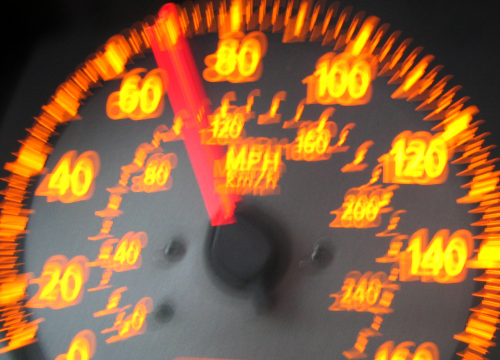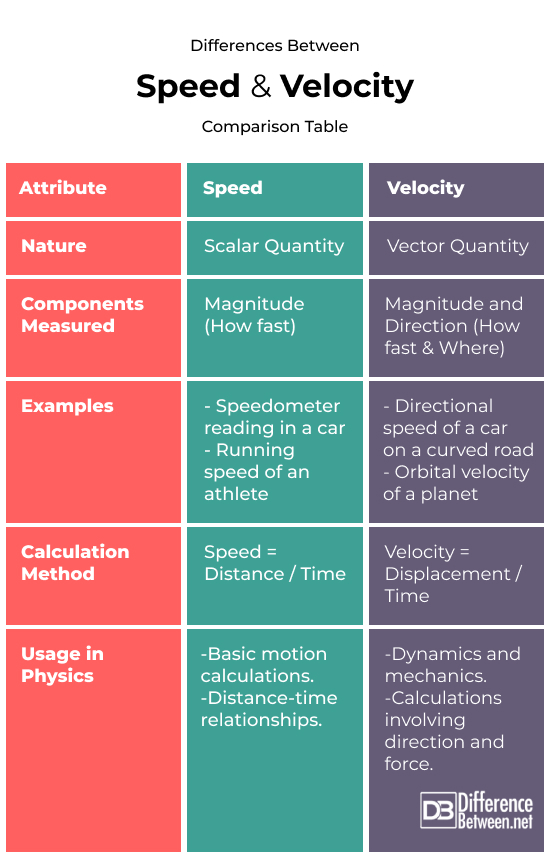Difference Between Velocity and Speed
INTRODUCTION:
Understanding Speed and Velocity
Velocity and speed are distinct but commonly misunderstood physics concepts. Formal and informal language are essential to comprehending motion. Moving rapidly is speed. Simple concept calculates time-travelled distance. Consider speed the numerical answer to “How fast is it going?” As a scalar, its only definition is magnitude.
Conversely, velocity complicates. Considers object speed and direction. Thus, velocity is a speed-direction vector. Velocity indicates speed and destination.
More than academic study is needed to grasp these ideas. Physics relies on them to understand and predict motion. Speed and velocity explain motion in planets and cars. They support cutting-edge astrophysics, mechanical engineering, and other subjects. Professionals, educators, and students must understand velocity.

What is speed?
Speed Definition
Speed is the rate at which an item travels, is crucial to physics. As a scalar quantity, it is described only by magnitude, not direction. Simply put, speed answers “How fast is an object moving?”
Speed Measurement Explained
Speed usually equals distance per unit time. The most popular speed units are metric metres per second (m/s) and imperial miles per hour (mph). Speed (v) is computed by dividing the distance (d) by the time (t) to traverse that distance, by the formula:
v=d/t
This formula explains speed calculations in everyday circumstances as well as complex scientific analyses.
Real-World Speed Examples
The speedometer of a car indicates its speed in real time. A automobile at 60 mph travels 60 miles in an hour, assuming constant speed.
- Athletics: Speed is crucial in track and field. A sprinter who covers 100 metres in 10 seconds averages 10 m/s.
- Aeroplane cruising speed is commonly described. A commercial jet may fly 500-600 mph.
- Rivers: River flow is like speed, measured in kilometres or miles per hour.
In both practical and theoretical situations, speed provides a clear, basic measure of how fast something is going.

What is Velocity?
Velocity Definition
Velocity is a vector quantity that describes speed and direction. Speed simply tells us how fast something is going, but velocity also shows the direction of travel. The conventional unit of velocity is m/s in a given direction.
Velocity distinguishing features, including direction
The direction of velocity separates it from speed. The velocity of an object varies if it changes direction, even if its speed remains constant. Velocity is a vector with magnitude (speed) and direction.
Formula for calculating velocity:
Velocity = displacement/Time
Vector displacement is an object’s position change. Displacement, unlike distance, displacement only considers initial and terminal positions, not the path traveled.
Real-World Speed Examples
- Driving on a Curved Road: Even though your speedometer stays the same, your velocity changes owing to the change in direction when you drive around a curve.
- Aircraft navigation: Velocity matters. A plane traveling north at 500 km/h has a velocity of 500 km/h north. After turning east at the same pace, its velocity becomes 500 km/h east.
- Sports: A football player going directly toward the goalpost has a certain velocity. When a player quickly changes direction yet maintains speed, their velocity changes.
- Astronomy: Planets orbiting the sun have a velocity that encompasses their speed and direction at any given time.
Understanding velocity is important in these situations because it provides more information than speed. It predicts and analyzes object motion more accurately by considering both speed and direction.
Similarities Between Speed and Velocity
Both speed and velocity measure motion. Essentially, they both indicate speed. These terms describe how objects move, such cars traveling along the street or planets orbiting the sun.
In kinematics, which studies motion without addressing its causes, speed and velocity are crucial. They are among the first physics concepts taught and essential for understanding complex physical phenomena.
Can be calculated and shown mathematically: Speed and velocity have precise mathematical formulas. Divide distance by time to find speed. Divide displacement by time to find velocity. These mathematical representations enable reliable calculations and estimates in many sciences and engineering domains.
Key differences between speed and velocity
Understanding motion in physics necessitates the distinction between speed and velocity. The primary distinctions are as follows:
Scalar vs. Vector Quantity:
Speed is a scalar quantity that just measures magnitude (how quickly an object moves) without taking direction into account.
The velocity is a vector. It takes motion direction and magnitude into account. This distinction is significant in physics because it influences how these values interact with other calculations and concepts.
Measurement Components:
Speed is only a measure of magnitude. It calculates the distance traveled by an object over time, regardless of direction. Velocity, on the other hand, is both magnitude and direction. It determines the speed and direction of an object.
Physics Equations and Concepts Affected:
Speed is used in distance and time calculations such as journey duration and fuel economy.
Velocity is required in vector mechanics and dynamics. Understanding momentum, acceleration, and forces is critical when direction matters in a physical system.
Speed in Technical and Everyday Language: In everyday English, speed refers to how quickly something moves, such as a car or runner.
More velocity is used in technical and scientific situations. It is used in engineering and astronomy since direction is as important as rate.
Methods of Calculation for Various Situations:
Speed is measured by speedometers as distance divided by time.
To calculate velocity, vector displacement is calculated over time. It frequently necessitates more lengthy thought, especially when changing directions.
These contrasts demonstrate that speed and velocity are related yet serve different motion analysis goals. Understanding these properties is critical for accurately characterizing and predicting moving object behavior in everyday observations as well as complicated scientific inquiries.
Differences between speed and velocity: Comparison table

Summary
Representing the main differences and similarities between speed and velocity reveals that both are fundamental to motion but serve different physical purposes:
Time-based speed measures how fast an object is moving.
Velocity quantifies time-dependent movement rate and direction.
Physics uses both to calculate and predict motion. Distance and time calculations in physics and daily life use speed. Complex physics applications like forces, momentum, and acceleration require directional velocity.
Professionals and students of physics must understand speed and velocity. It allows people accurately describe and understand motion in everyday observations and large scientific studies. Learn the differences between these two concepts to comprehend physical motion dynamics.
FAQs
1. Are speed and velocity ever the same?
Yes, speed and velocity can be the same in magnitude when an object moves in a straight line in a constant direction. In such cases, the speed value equals the magnitude of the velocity. However, velocity also includes direction, which speed does not.
2. What is faster, velocity or speed?
The question isn’t about “faster” as speed and velocity are different concepts. Speed is the rate of motion, while velocity is speed with a directional component. One isn’t faster than the other; they’re just measured differently.
3. How do you find speed from velocity?
To get speed from velocity, you need to find the length of the velocity vector. This means that you should only look at how fast the thing is moving and not where it is going.
4. What is an example of velocity?
A car going northeast at 60 km/h is an example of speed. This says both how fast the car is going (60 km/h) and which way it is going (northeast).
5. What is the difference between speed and velocity in sportingexamples?
In sports, “speed” could mean how quickly a runner finishes a race, no matter what route they take. They would be moving at a speed and a direction, like a runner going straight at 10 m/s.
6. What is the difference between speed, velocity, and acceleration?
How fast something moves is called its speed. This speed has a direction added to it by velocity. Acceleration is the speed or direction at which motion changes, like when a car speeds up, slows down, or turns.
- Difference Between Suicide and Euthanasia - May 22, 2024
- Difference Between Vitamin D and Vitamin D3 - May 21, 2024
- Difference Between Running Shoes and Walking Shoes - April 30, 2024
Search DifferenceBetween.net :
13 Comments
Trackbacks
- Difference Between DVD-R and DVD+R | Difference Between
- Difference Between SSD and Hard Drive | Difference Between | SSD vs Hard Drive
- Difference Between Jogging and Running | Difference Between | Jogging vs Running
- Difference Between Cat5e and Cat6 | Difference Between | Cat5e vs Cat6
- Difference Between Cyclone and Hurricane | Difference Between | Cyclone vs Hurricane
- Difference Between Nokia N Series and E Series | Difference Between | Nokia N Series vs E Series
- Difference Between Cement and Concrete | Difference Between | Cement vs Concrete
- Difference Between USB and Firewire | Difference Between | USB vs Firewire
- Difference Between Emu And Ostrich | Difference Between | Emu And Ostrich
- Difference Between HorsePower and Torque | Difference Between | HorsePower vs Torque
- Difference Between Reflection and Refraction | Difference Between | Reflection vs Refraction
Leave a Response
References :
[0]Image credit: https://www.canva.com/photos/MAED9wbk0qY-high-velocity/
[1]Image credit: https://www.canva.com/photos/MADByfOKHOw-speed-motion-on-road-at-night/
[2]Hewitt, P. G. (2023). Linear Motion. In Conceptual Physics (pp. 64–84). essay, Pearson Education Limited.
[3]Yıldız, A. (2016, April). A discussion on velocity–speed and their instruction. In Journal of Physics: Conference Series (Vol. 707, No. 1, p. 012040). IOP Publishing.
[4] Daniëls, N. E., Bartels, S. L., Verhagen, S. J., Van Knippenberg, R. J. M., De Vugt, M. E., & Delespaul, P. A. (2020). Digital assessment of working memory and processing speed in everyday life: Feasibility, validation, and lessons-learned. Internet interventions, 19, 100300.
[5]1 Hewitt, P. G. (2023). Linear Motion. In Conceptual Physics (pp. 64–84). essay, Pearson Education Limited.
[6]2 Hewitt, P. G. (2023). Linear Motion. In Conceptual Physics (pp. 64–84). essay, Pearson Education Limited.
[7]3 Daniëls, N. E., Bartels, S. L., Verhagen, S. J., Van Knippenberg, R. J. M., De Vugt, M. E., & Delespaul, P. A. (2020). Digital assessment of working memory and processing speed in everyday life: Feasibility, validation, and lessons-learned. Internet interventions, 19, 100300.
[8]4 Hewitt, P. G. (2023). Linear Motion. In Conceptual Physics (pp. 64–84). essay, Pearson Education Limited.
[9]5 Hewitt, P. G. (2023). Linear Motion. In Conceptual Physics (pp. 64–84). essay, Pearson Education Limited.
[10]6 Hewitt, P. G. (2023). Linear Motion. In Conceptual Physics (pp. 64–84). essay, Pearson Education Limited.
[11]7 Hewitt, P. G. (2023). Linear Motion. In Conceptual Physics (pp. 64–84). essay, Pearson Education Limited.

Hello, and thanks for this explanation. It seems that every several years I have to refresh my memory on this question.
By the way, I suggest a slight correction: “one in the same” is a misspelling of “one and the same.”
this is good but this is not in tabular form